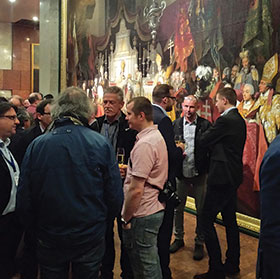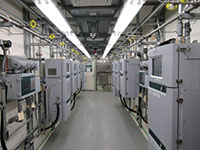

The 'User Group' conferences, which provide a meeting place for automation and control managers and engineers from different companies and industries to get together and share their operational experience, started in the USA, and have blossomed in Europe in the last few years. Usually hosted by a major supplier, they encourage their clients to come together in a way that is more cost effective, for them, than a standard commercial exhibition and conference. But they also always gather their normal specialist sub-suppliers as partners, to show and talk about their products, and explain how they can interface together to create a total plant system, in the mini-exhibition running alongside meal and coffee breaks.
In October this year, Yokogawa will bring its User Group meeting to South Africa, for three days in Johannesburg, so it is relevant to report here on the similar European event – which took place this May in Budapest. It attracted around 200 engineers and interested editors from all around Europe: from Spain to Norway, from the UK to Turkey, to hear about recent new applications, and the latest product developments.
'Transformation 2017' is the current Yokogawa business plan, covering the three years from 2015-17: the year 2015 also happened to be the 100th year since the foundation of the company. So its anniversary year plan focuses on customer interfacing and 'Co-Innovation', which was the main conference theme for the presentations.
Yokogawa appears to have developed a different approach recently, and has become keen to bring in ideas, products and even make acquisitions to broaden its expertise base. It did this previously, but there is a greater emphasis now, it seems. It is also the ISA 100 wireless sensor technology leader, amongst the main automation companies, and is helping more small sensor manufacturers to develop this capability.
Wireless sensors to ISA 100
Yokogawa has produced wireless versions of its own temperature and pressure transmitters, as you would expect, plus have the routers and base stations necessary to complete the site system. More interesting, it has developed a wireless module, which can be integrated with other (third-party supplier) sensors, to create a new wireless measurement sensor. It also has a battery pack that can be exchanged in a hazardous area, when needed, often only after ten years, but maybe after two years if that battery also powers a third-party sensor and needs a fast data response time.
In a presentation about a Richter Gedeon Group pharmaceutical plant in Romania, Yokogawa described a wireless sensor installation that monitored the groundwater levels around the site, in 20 wells over an area 1500 x 600 m, with some wells actually outside the factory fence. The historic weekly manual monitoring was not felt to be sufficiently frequent, and current environmental standards required an improvement, to at least four times a day. Standard HART submersible pressure sensors were used for the level measurement, powered by the battery pack in the Yokogawa wireless module, which communicated digitally with the sensors and then sent the data over ISA 100 links. This provides hourly reporting data from each well, and allows the sensor to be put into sleep mode between readings.
The large area of the site, the topography and pipe bridges, provided a challenge for the wireless links. To achieve the transmission distances involved, Yokogawa planned the site layout with four of its independent wireless routers, to gather data from the local sensors at the extreme distances, and then use the superior range achievable from the router to the base station to deliver the data. This was then displayed by the pre-existing site ABB 800XA control system, to present any alarm data to the operators, and archive the records.

The IIoT and 'Sushi Sensors'
Yokogawa says it has been working on the development of low-cost, small, battery-operated wireless sensors, perhaps aptly named as 'Sushi Sensors', for 10 years, as well as learning what associated data analysis is required to come to a meaningful conclusion about what the data – 'Big Data' – is saying. So it was good to see its Sushi sensors on display, in different colours (as you might expect: blue, yellow/gold, and silver) – all with a little stub aerial. But turn these little bugs over and there was an empty shell – nothing there yet! Nevertheless, the work is going on, initially to produce temperature sensor systems: watch this space.
On other stands, the GasSecure GS01 hydrocarbon gas detector was on show, which is another ISA 100 wireless sensor from Dräger, marketed by Yokogawa for LNG and oil and gas facilities. Next, Spirax Sarco presented its latest wireless sensor, used for monitoring steam traps on petrochemical plants. Available only recently, from March 2016, this sensor uses the standard ISA 100 system, and is called STAPS (which stands for Spirax Total Acoustic Performance Solutions). The acoustic sensing uses a PZT sensor clamped to the outside of the steam line alongside the trap, which can indicate when the trap is blocked, or when it has failed open and is leaking live steam. Not only does the STAPS sensor calculate and transmit the rate of steam loss, so the operator can assess the cost and therefore the urgency needed to make a repair, it can analyse the actual type of trap failure. This is done within the sensor electronics, by measuring the emitted acoustic signatures in multiple bands between 5 and 40 kHz, to suggest whether the problem is dirt, or a sticky valve, or a damaged valve seat. The STAPS sensor is available intrinsically safe, for petrochemical applications: Spirax previously offered a different wireless sensor for standard industrial plants and boiler rooms, which used a Zigbee communications link.
Customer software and co-innovation
There have been two Yokogawa acquisitions in the field of 'management' software, which are focused on making the computer-based control systems supplied by Yokogawa for plant and process control provide the overview data required by management, improving the connectivity between plant and office, and optimising business operations.
First, it acquired Industrial Evolution in January 2016, which provides cloud-based plant data sharing services, or DaaS (Data-as-a-Service). Yokogawa renamed this business Industrial Knowledge: this service has been used in a broad variety of applications such as the sharing of data on oil and gas field operations among authorised users at multiple companies, and the real-time sharing of data with investors on facilities that are operated by third parties. For example, when an oilfield is jointly owned by three companies, but only one of them acts as the main operator.
Then in April, Yokogawa acquired KBC Technologies, a successful provider of software and consultancy focused on achieving operational excellence and improving profitability for both the upstream (oil production) and downstream (oil refineries and petrochemicals production) segments, through advanced software for process optimisation and simulation.
Originating with three process engineers who started life at the Exxon Fawley refinery, KBC also now incorporates the original Honeywell HPS reactor technology expertise, acquired in 1998, and the chemicals processing technology developed at Infochem, acquired in 2012.
Combining KBC and Industrial Evolution into its Industrial Knowledge business, Yokogawa is expanding its advanced solutions service by engaging with its customers in a co-innovation process, to add value, using company-wide optimisation of the business operations.
Co-innovation with the specialists
Oil fiscal metering using specialist skids at oil tanker batch shipping terminals is a major application area for Coriolis meters. Yokogawa has just upgraded its Coriolis product line to improve the performance using modern electronics and sensor technology. The pressure drop for a given flow rate has been greatly reduced, and on-site accuracy enhanced to meet the laboratory tested specifications. In addition, tube condition monitoring enables on-site checks to confirm that the process conditions have not affected the measurement tubes.
Unlike other Coriolis suppliers, Yokogawa do not offer an in-house fiscal metering skid production facility, but relies on the knowledge of its specialist customers to achieve the total package offer. So via its chosen skid supplier customer, M+F Technologies of Hamburg, it has supplied meters for terminal management systems, tank truck loading systems, aircraft and ship supply across the world. The M+F MFX4 batch flow computer has been supplied for blending, leak detection and terminal operations in Latin America, Russia, EU, and Cuba. The latest Yokogawa Coriolis meters, the TI product range, has enabled M+F to reduce the size of the gas separators involved, reducing the skid footprint, and also M+F has reduced the maintenance costs associated. Using TCP/IP communications the system has 24/7 remote maintenance available, essential for 24 hour terminal operations.
Conclusion

The two or three conference days crammed in a lot more than was described above, the delegate just chooses the topics of major interest on his plant. Further announcements showed that Yokogawa is to construct complete analyser house systems in Spain, in addition to the existing facilities in Singapore and USA, to serve the European market primarily. Here it acts as the site systems supplier, perhaps in contrast to the approach to fiscal metering described above. Yokogawa is also collaborating with Cisco Systems over the Shell SecurePlant initiative, which is to be rolled out over 50 Shell plants, and has developed an interesting collaboration with StatOil, to use wireless sensors to monitor the on-site sound noise level on offshore oil platforms, to ensure personnel safety and monitoring. More of this will come later . . .
Nick Denbow spent 30 years as a UK-based process instrumentation marketing manager, and then changed sides – becoming a freelance editor and starting Processingtalk.com. Avoiding retirement, he published the INSIDER automation newsletter for five years, and then acted as their European correspondent. He is now a freelance Automation and Control reporter and newsletter publisher, with a blog on www.nickdenbow.com
© Technews Publishing (Pty) Ltd | All Rights Reserved